



Coccidiosis vaccine EVANT® shows ability to reduce intestinal lesions associated with Necrotic Enteritis
Efficacy of an attenuated coccidiosis vaccine in combination with different feed additives on production performance and intestinal lesions in broilers challenged with necrotic enteritis.Introduction
Coccidiosis is one of the most common and widespread diseases in commercial poultry. Coccidiostats continue to be the most widely used prevention tool in broilers. Reduced sensitivity of Eimeria parasites due to prolonged exposure to these drugs together with the ever-increasing need to reduce antibiotic use have drawn the attention of poultry producers towards the use of anticoccidial vaccines. The objective of this study was to evaluate the efficacy of an attenuated coccidiosis vaccine for broilers (EVANT®), in combination with different in-feed additives in broilers challenged with necrotic enteritis (NE).
Coccidiosis vaccines are indicated to decrease the intestinal lesions caused by specific Eimeria species which are a known predisposing factor to NE (8, 9) and, consequently, these vaccines could be a holistic approach to the control of NE disease and an alternative solution to coccidiostats.
Over the last few years, feed additives have gained special attention from the poultry industry as tools to improve zootechnical performance (1, 2) and as an alternative solution to antimicrobials. This is the case of organic acids like Short-chain fatty acids (SCFA) and Medium-chain fatty acids (MCFA) (6, 7, 10), or phytogenic feed additives (PFA) (5, 7). The combination of vaccination against coccidiosis and the supplementation of the diet with the above-mentioned feed additives could be a composite approach to the control of NE problems triggered by Eimeria spp. infestation in broilers.
Therefore, the objective of this study was to test the efficacy of an attenuated coccidiosis vaccine in combination with different feed additives in preventing loss of production performance and intestinal lesions in broilers challenged with NE.
Materials and Methods
Birds and diets
Broiler chicks were supplied from a commercial source and housed at the Schothorst Feed Research facilities.
The standard diets were formulated without coccidiostats and antimicrobial growth promoters. Moreover, the grower feed diet was formulated to provide predisposing factors for NE development. Therefore, feedstuffs rich in non-starch polysaccharides were provided, whereas enzymes like glucanase and xylanase were omitted. The tested diets were prepared by supplementing the standard diet with SCFA, MCFA, or Phytogenic Feed additives (PFA) throughout the study.

Experimental design
Chickens were distributed between 6 experimental groups (Table 1). Groups 3, 4, 5 and 6 were vaccinated at one day of life against coccidiosis with EVANT®. The rest of the groups were not vaccinated. Groups 1, 2 and 3 were then reared without feed additives in the diet, whereas groups 4, 5, 6 were reared with MCFA, SCFA or PFA respectively in the diet. NE was then experimentally induced in groups 2 to 6, whereas group 1 was sham-infected. Body weights (BW) and feed intake (FI) were recorded during the study. Intestinal lesions were scored according to different methods depending on whether it was for E. maxima (3) or for C. perfringens (4). Finally, excreta samples were periodically collected to evaluate the dynamics of oocyst excretion after vaccination and after challenge (Table 2). The birds were monitored until 42 days post-vaccination (dpv) as shown in Table 2.
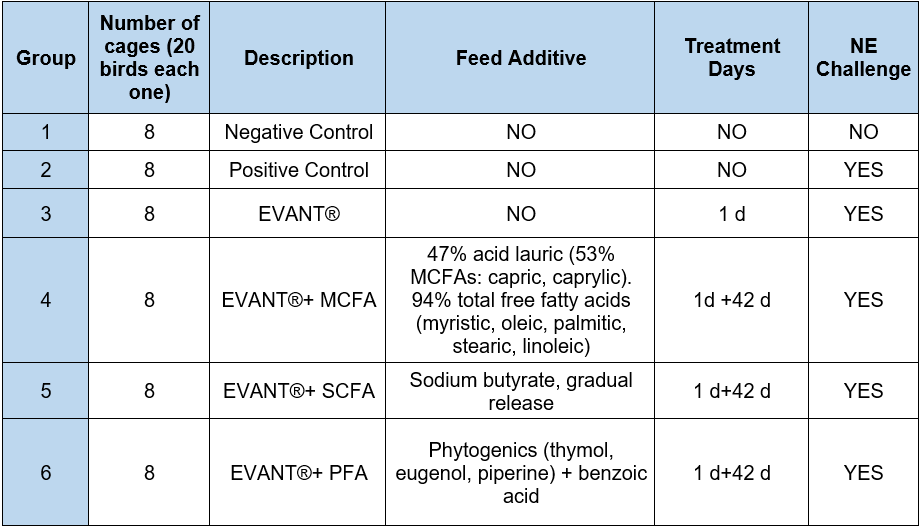
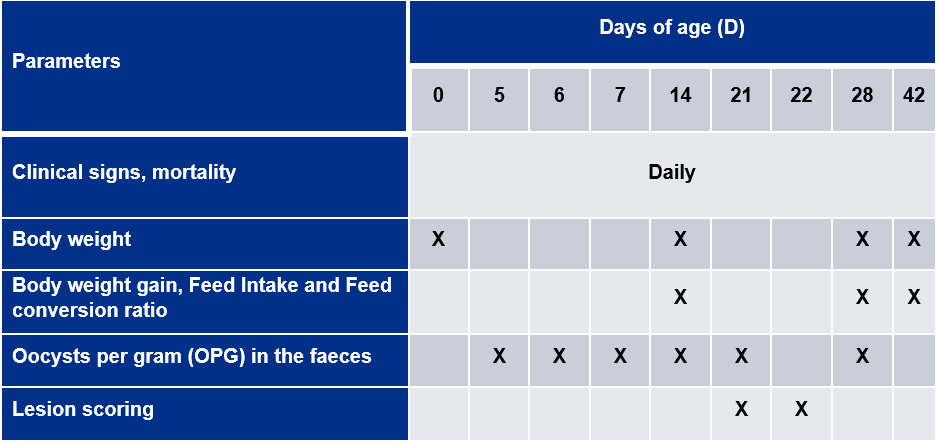
Results
Bird health
The experimental NE challenge in the non-vaccinated group of birds showed a slight but not significant increase in mortality and a significant increase in intestinal lesions associated with E. maxima and C. perfringens (Graphics 1 and 2). Vaccine administered alone or in combination with feed additives in the diet significantly decreased the intestinal lesion score associated with C. perfringens and slightly but not significantly the mortality compared to the untreated group; the lack of significant differences in mortality was probably due to the high variation (Graphic 2). MCFA supplemented group was the only one which showed a synergistic effect with the vaccine; thus, a further statistically significant decrease in the intestinal lesion score associated with C. perfringenswas observed.


a-c Values without a common superscript within a column are significantly different (P ≤ 0.05).
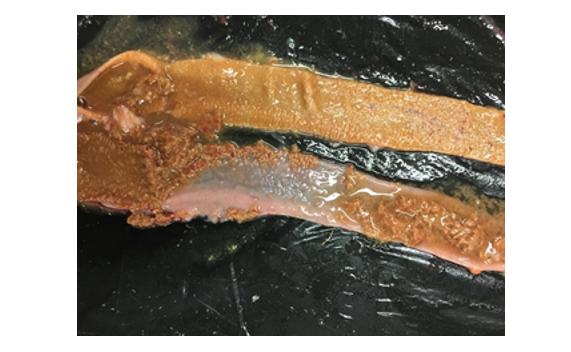
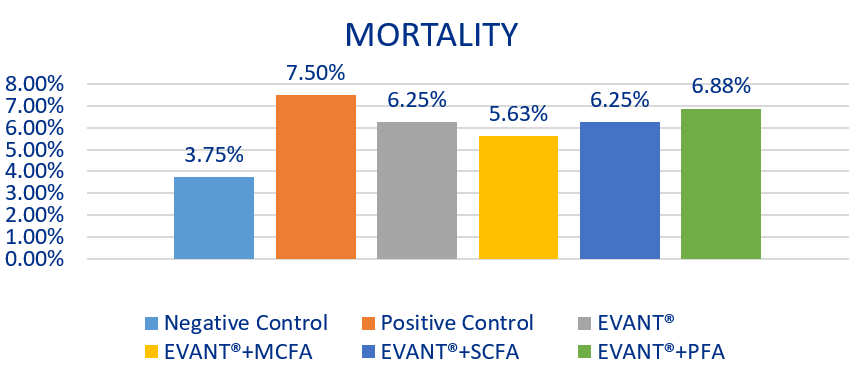
Productive performances
The effect on body weight (BW) due to NE was seen shortly after the challenge (Graphic 3). The disease reduced the growth of the birds as demonstrated by the lower body weight (BW) and higher feed conversion ratio (FCR) (Graphic 4) the main effect of the disease on the productive performances was observed at 28 dpv and growth losses were compensated by birds afterwards but with less efficiency.
After the NE challenge, vaccinated birds grew and converted feed better than the non-vaccinated as shown by the higher BW (except MCFA group) and lower FCR (Graphics 4-5). A compensatory growth after the challenge (28-42 dpv) was probably the cause of the observed lack of significant benefits on this parameter at 42 dpv. The supplementation of the diet with feed additives did not further improve the body weights of the vaccinated birds after the NE challenge (28 dpv); thus, no statistically significant differences in those parameters were found. However, the group with MCFA was the only one among those with a diet supplemented with additives which converted the feed more efficiently, as shown by the lower FCR in the overall period (Graphic 5).
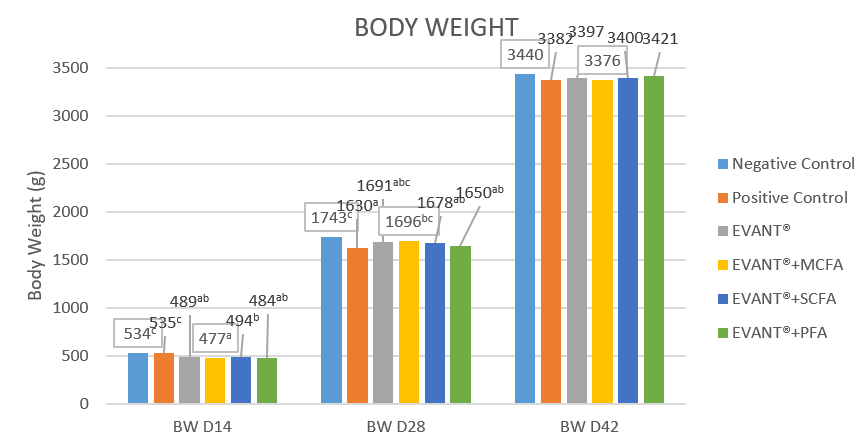


Oocyst excretion in the faeces
The number of Eimeria spp. oocysts excreted in fresh faeces was counted to check the vaccination as well as the challenge performances (Graphic 6). The period between 5 and 7 dpv, and 14 dpv generally corresponded to the excretion of the vaccine’s attenuated strains during the first and second replication cycles respectively. Vaccinated groups showed excretion of certain levels of oocysts during that period, indicating a successful vaccination process. After the challenge (21 dpv), the oocyst excretion greatly increased in challenged groups, which was consistent with the replication of the inoculated E. maxima. Non-vaccinated and challenged group showed the highest levels of oocyst excretion. On 28 dpv, the oocyst excretion was low in all treatments and without significant treatment effects.
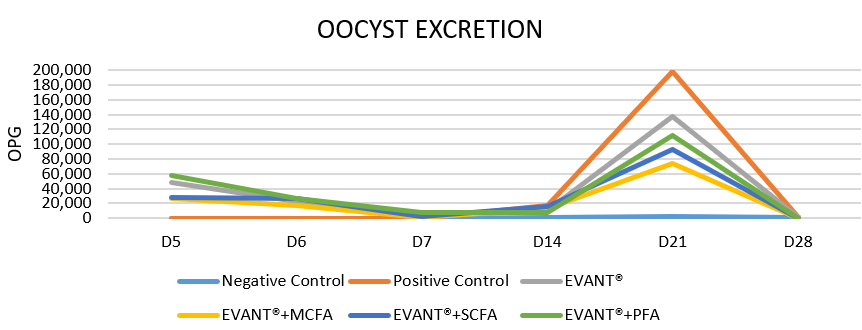
Discussion & Conclusion
In this study, vaccination with EVANT®, an attenuated coccidiosis vaccine for broilers, was shown to be able to reduce intestinal lesions associated with NE. Intestinal lesions associated with C. perfringens were reduced compared to non-vaccinated birds and, as a consequence, benefits in productive performances were observed as well. Feed conversion was improved compared to non-vaccinated birds during the critical period of the disease. The supplementation of SCFA- and PFA- based feed additives in the diet of vaccinated birds did not provide more benefits than the vaccine alone. MCFA were shown to be able to further decrease intestinal lesion scores associated with C. perfringens than vaccination alone, and a significant improvement in the feed conversion efficacy was observed.
In conclusion, the vaccination with EVANT® reduced the intestinal lesions caused by a NE disease triggered by E. maxima, a predisposing diet and C. perfringens infection; therefore, it also prevented some of the productivity losses associated with the disease. Supplementation of MCFA to the diet of vaccinated birds further reduced the intestinal lesions caused by the same NE challenge model compared to vaccination alone and improved the feed conversion of birds regardless of the NE challenge.
| References | ||||
|---|---|---|---|---|
| 1. Cave N.A.G., | ||||
| (1982) | Effect of Dietary Short-Chain and Medium-Chain Fatty-Acids on Feed-Intake by Chicks.. Poult Sci. | 61(6):1147–53. | ||
| 2. Hankel J., Popp J., Meemken D., Zeiger K., Beyerbach M., Taube V., Klein G., Visscher C., | ||||
| (2018) | Influence of lauric acid on the susceptibility of chickens to an experimental Campylobacter jejuni colonisation.. PLoS One, | |||
| 3. Johnson J. and Reid W.M., | ||||
| (1970) | Anticoccidial drugs: Lesion scoring techniques in battery and floor-pen experiments with chickens.. Ex Parasitol. | 28(1):30-36. | ||
| 4. Lensing M., van der Klis J.D., Fabri T., Cazemier A., Else A.J., 2010. Efficacy | ||||
| (2010) | Efficacy of a lactylate on production performance and intestinal health of broilers during a subclinical Clostridium perfringens infection.. Poult Sci. | 89: 2401-2409. | ||
| 5. Mitsch P., Zitterl-Eglseer K., Köhler B., Gabler C., Losa R, Zimpernik I., | ||||
| (2004) | The effect of two different blends of essential oil components on the proliferation of Clostridium perfringens in the intestines of broiler chickens.. Poult Sci. | 83(4):669-75. | ||
| 6. Skrivanová E., Marounek M., Dlouhá G., Kanka J., 2005. Susceptibility of Clostridium perfringens to C-C fatty acids. | ||||
| (2005) | Susceptibility of Clostridium perfringens to C-C fatty acids.. Lett Appl Microbiol | 41(1):77-81. | ||
| 7. Timbermont L., Lanckriet A., Dewulf J., Nollet N., Schwarzer K., Haesebrouck F., Ducatelle R., Van Immerseel F., | ||||
| (2010) | Control of Clostridium perfringens-induced necrotic enteritis in broilers by target-released butyric acid, fatty acids and essential oils.. Avian Pathol. | 39(2):117-21. | ||
| 8. Williams R.B., Marshall R.N., La Ragione R.M., Catchpole J., | ||||
| (2003) | A new method for the experimental production of necrotic enteritis and its use for studies on the relationships between necrotic enteritis, coccidiosis and anticoccidial vaccines of chickens.. Parasitol Res. | 90: 19-26. | ||
| 9. Williams R.B., | ||||
| (2005) | Intercurrent coccidiosis and necrotic enteritis of chickens: rational, integrated disease management by maintenance of gut integrity.. Avian Pathol. | 34, 159-180. | ||
| 10. Yoon B.K., Jackman J.A., Valle-González E.R., Cho N.J., | ||||
| (2018) | Antibacterial Free Fatty Acids and Monoglycerides: Biological Activities, Experimental Testing, and Therapeutic Applications.. Int J Mol Sci. | 19(4):1114. |









